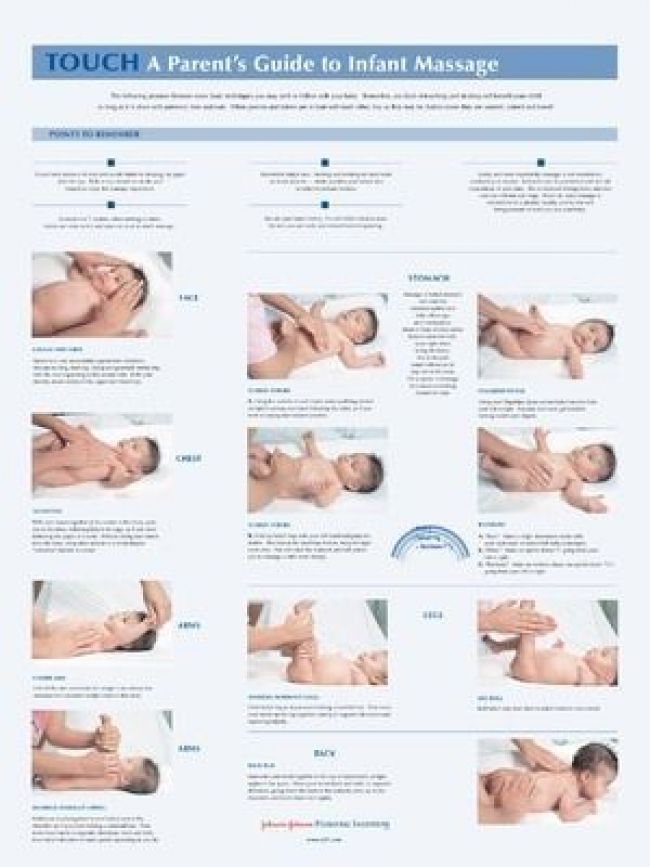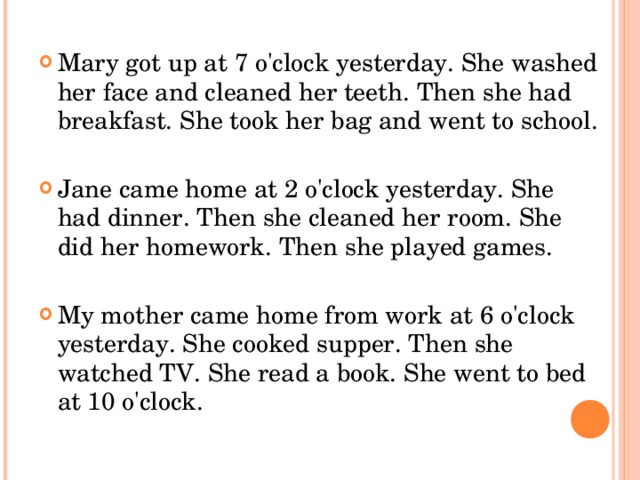Baby massage after feeding
Baby Massage: How and Why You Need to Do It
From improved sleep to a better bond, baby massage has so much to offer baby and caregiver. Find out more, plus learn the best techniques.
What’s not to love about a massage? No matter what kind of massage you get—from a deep tissue massage to a prenatal massage and even a perineal massage (OK, that’s a bit of a stretch)—you receive physical and mental benefits. So why not try baby massage for your littlest one. There are some significant benefits to infant massage that we’ll explore in this post.
With that in mind, in this post we’ll explain:
How to Do a Baby Massage
You’re ready to massage baby, but what exactly are you supposed to do? Just follow a few simple steps:
1. Set the mood
Dim the lights, shut off your phone, turn on some soft music if you’d like, and make sure the room is warm. What’s considered warm? About 75 degrees F.
2. Place baby on a safe surface
Choose a comfortable, but flat surface. This may be a floor, your bed (don’t leave baby unattended!), or baby’s changing table.
3. Undress baby
You can ditch the diaper if you want. A little air time will even be beneficial for baby’s bum if she has a diaper rash or heat rash. Just be sure to slide a towel or two under baby if they are diaper-free. The prefold inserts for cloth diapers work well in this situation.
4. Gentle touch
Now is not the time for tickling. You want a calm, peaceful mood. For small infants, use soft, gentle strokes. For toddlers, you can use more firm “massage” strokes. Think of a massage stroke as smoothing your baby’s skin, rather than rubbing it.
5. Target the right body parts
Benefits of Baby Massage – Mother Massaging Baby’s Foot
Massage baby’s feet using soft, gentle strokes.
Benefits of Baby Massage – Mother Massaging Baby’s Legs
Massage baby’s legs, working the shins and the thighs.
Benefits of Baby Massage – Mother Massage Baby’s Arms
Move to the arms, making sure to massage baby’s hands, too.
Benefits of Baby Massage – Mother Massage Baby’s Stomach
For baby’s stomach, massage in a clockwise direction (the same way as baby’s digestive system moves).
Benefits of Baby Massage – Mother Massage Baby’s Chest
Massage baby’s chest, but avoid the delicate head and neck area.
Benefits of Baby Massage – Mother Massage Baby’s Back
Flip baby over and massage his/her back.
*Avoid massaging the head since your baby still has soft spots
6. Bond with your baby
Talk softy, sing a lullaby, or gently shhhhh your baby. Look baby in the eyes to enhance the connection between the two of you.
7. Know when to stop
If baby starts to fuss, stop the massage and resume at a later time. Common reasons why babies start to fuss during a massage is that they are hungry, too cold, or even bored. Hey, babies are human too! ?
Feeling motivated? Here’s a good example of infant massage:
Do I Need Baby Massage Oil?
While you don’t need baby massage oil, using massage oil can make the experience more comfortable and enjoyable, because it lessens the friction between skin.
According to a study published in the journal Indian Pediatrics, the type of massage oil you use can affect the health and growth of your baby. Researchers found that when coconut oil (as opposed to mineral oil) was used, the babies (both preterm and full-time) gained more weight.
Recent research from the University of Manchester also studied the role of oil used in baby massages, and found that olive oil and sunflower oil seemed to break down baby’s skin barrier function. Babies massaged with these oils were more at risk for developing skin conditions like baby eczema.
Get free updates on baby’s first year! – Free Updates on First Year [In-article]
Sign me up!
Best baby massage oil
- Coconut oil: Yes, just use a small dap of coconut oil for your massage oil. Babies don’t need fancy! Coconut oil is antimicrobial, anti-bacterial, anti-fungal, and antiviral. I kept a small jar in my baby’s drawer, as I used coconut oil for diaper cream as well. (This is my favorite brand.)
- Whipped Shea Butter with Coconut oil: If your baby has drier skin, shea butter helps to hydrate and seal in moisture. This whipped cream is mixed with coconut oil for added benefit. No other ingredients. (You can purchase here.)
- YL Seedlings: If you want something to add in the therapeutic value of essential oils, try this gentle and nourishing baby massage oil. (Get more info on ordering YL here.)
Using essential oils
Never apply undiluted essential oils to a baby’s skin—they are too concentrated and can cause allergic reactions, skin irritations, or a detox response.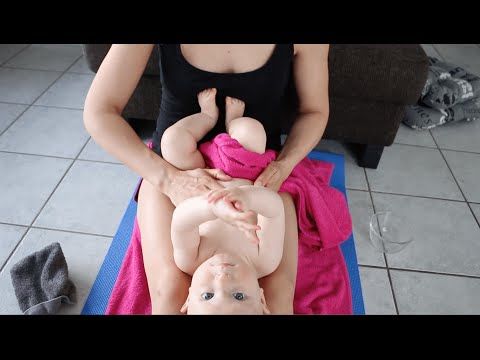 Always ensure proper dilution ratios when using essential oils near or for children. Best to use occasionally versus daily.
Always ensure proper dilution ratios when using essential oils near or for children. Best to use occasionally versus daily.
When to Massage Baby
For most parents, only five minutes per diaper change is enough to encourage a healthy digestive system, ease symptoms of colic, and promote a quiet and restful evening. (source)
Age
It’s never too early to start massaging your baby. Your baby’s first massage might even be on his birth day when you rub in the vernix. However, if you massage a newborn, you’ll want to be extra careful when using any oils on his sensitive newborn skin.
Time of day
The time of day you choose to massage your baby could make a difference in how well baby responds to the massage. Avoid massaging baby too soon after a feeding, since it may cause baby to spit up.
Some of the best times to massage baby are:
- About 45 minutes after eating
- When baby is calm, alert, and awake
- Right before bed
- After a diaper change
Benefits of Baby Massage
Infant massages are not new.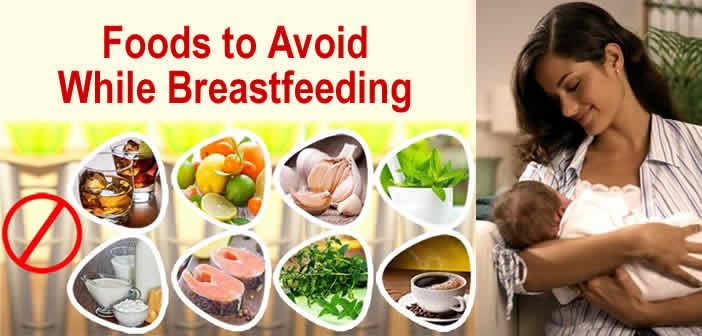 In fact, baby massages have quite the history. Evidence of the earliest infant massage dates back to ancient India. Even then, massages were more than just a form of relaxation—they were incorporated into Ayurvedic medicine as a way to enhance circulation, get rid of toxins, improve digestive function, and boost overall well-being. (source)
In fact, baby massages have quite the history. Evidence of the earliest infant massage dates back to ancient India. Even then, massages were more than just a form of relaxation—they were incorporated into Ayurvedic medicine as a way to enhance circulation, get rid of toxins, improve digestive function, and boost overall well-being. (source)
Today we know just how much a newborn benefits from massage and that all babies, particularly low birthweight babies, often thrive when exposed to human touch. Over 100 studies confirm the wide range of massage benefits for common maladies from gas to colic to sleeping problems. Let’s unpack some of the biggest benefits of baby massage:
1. Baby massage facilitates weight gain
When Stephanie Agakian gave her birth to her baby girl at 25 weeks gestation, she was a mere 1 lb 5 ounces. Agakian was told to massage her baby at home to promote growth and overall health. That’s because, many studies link massage with healthy weight gain.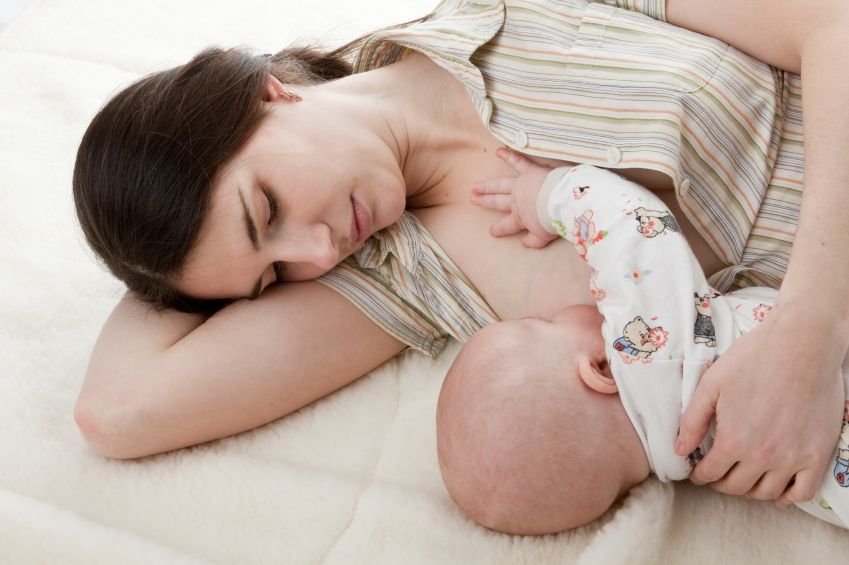
According to this study, premature babies who received “touch therapy” (a massage), gained 47 percent more weight than premature babies who did not receive any massages. (WOW!)
In another study, newborns who received massage gained more weight per day, appeared more aware, and had increased motor skills. A more recent study supports these findings, adding that baby massage increases bone density, too.
2. Baby massage lowers chance of jaundice
Recent studies suggest infant massage can also reduce bilirubin levels—the compound in blood that causes jaundice—and increase the frequency of bowl movement, which helps expel excess bilirubin from the body, not to mention constipation.
Benefits of Baby Massage – Mother Massaging Baby’s Foot
3. Baby massage reduces stress
There are many studies that show human touch reduces stress and lowers blood pressure in adults, and babies are no different. This study found evidence that massage therapy can be life-saving for premature babies.
This study found evidence that massage therapy can be life-saving for premature babies.
In one study, massaged babies showed improved heart rate variability (HRV)—a measure of nervous system function—every week. The researchers concluded baby massage markedly reduces stress and, therefore, promotes the maturation of preemies’ immature nervous systems.
So how do massages lower stress hormones? Touch causes endorphins to be released, which then causes cortisol to drop. As a result, babies’ “senses of safety and security are increased, and all of this brings the individual into a more balanced state of well-being overall,” says Ronda Cheatham, owner of A Touch of Grace Massage Therapy in Remington, Virginia.
4. Baby massage reduces colic
Have you ever wondered why so many infant seats, rockers, and swings have a vibrating feature? It’s because the vibration can actually help relieve colic. But research shows prolonged time in chairs or other baby containers are not good for baby’s development. This study found that infant massage is comparable to vibrating chairs in terms of successfully calming a colicky baby.
This study found that infant massage is comparable to vibrating chairs in terms of successfully calming a colicky baby.
5. Baby massage promotes sleep
Research from the University of Warwick found that baby massage lowers levels of cortisol, the stress hormone, and stimulates melatonin production. Because melatonin’s main job is to regulate sleep cycles, baby massage helps babies fall asleep faster and stay asleep longer. (Yippee!)
“Given the apparent effect of infant massage on stress hormones, it is not surprising to find some evidence of an effect on sleep and crying,” — Angela Underdown, University of Warwick
6. Baby massage strengthens bonds between mama (or papa) and baby
Studies show that the bond between baby and mama is reinforced through eye contact as well as skin-to-skin contact. Further research suggests infant massage is especially helpful for mothers with postpartum depression who have trouble bonding with their babies.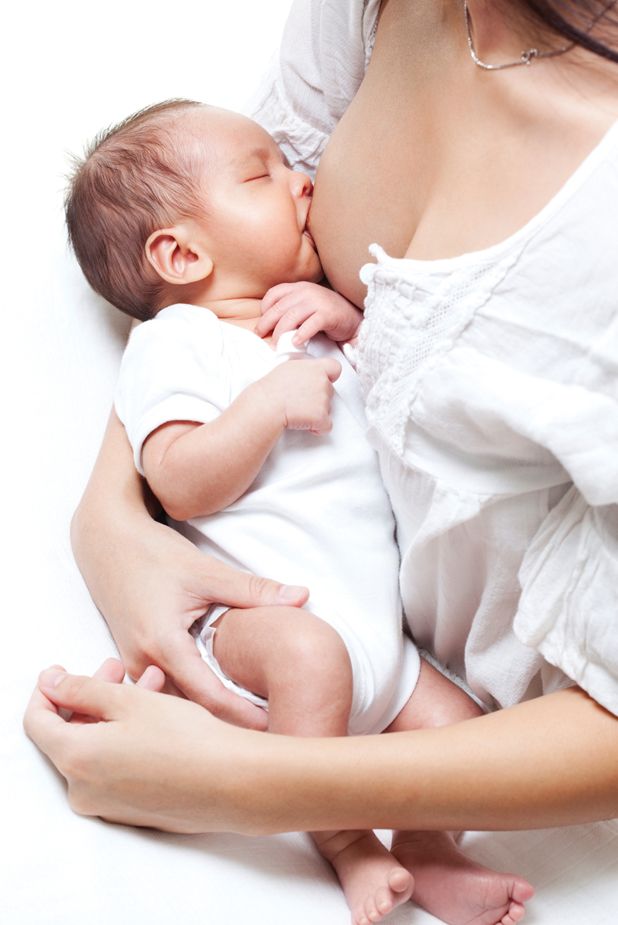
“When parents massage their baby, hormones are released to help [the parents] relax. Through massage, they learn to understand their baby, building their confidence…” — Linda Storm, founding executive director of Infant Massage USA
But the benefits don’t just apply to mama. A study published in the Journal of Perinatal Education found that baby massage significantly reduced paternal stress and improved the bond between dad and baby.
Studies also show that parents who practice infant massage are better able to communicate with their children. And parents of chronically ill children report lower levels of anxiety as a result of practicing baby massage.
7. Baby massage relieves gas or constipation
Because babies have an underdeveloped sphincter in their esophagus, they aren’t able to burp on their own. This causes gas to build up in their system, causing belly discomfort. Infant massage helps relieve that pressure, says Cheatham.
Gently knead your fingers under your baby’s rib clockwise (the direction that baby’s GI system runs) to promote good digestion and a healthy GI system. (For other natural constipation remedies, read this post.)
8. Baby massage enhances learning
Studies show that massages can promote alertness, and when baby is more alert, he/she learns more. In one study, 4-month-olds who were given 8-minute massages responded more favorably to audio-visual habituation tasks than infants who did not receive massage.
“A relationship has been shown between skin-to-skin touch and intelligence,” says Koch. “The more tactile stimulation a baby receives in its first months of life up through the first year can impact their brain development permanently.”
Another study shows that this benefit of massage applies to preschoolers as well. When preschoolers are tested post-massage, they perform better.
9. Baby massage improves certain conditions
Just like massage therapy can be used to treat various conditions in adults, massage therapy can also be used to treat conditions in babies and young children. For instance, children diagnosed with autism spectrum disorder performed better on tests after a massage. The same was true for children with ADHD. Other pediatric psychiatric disorders that were also improved by massage included:
For instance, children diagnosed with autism spectrum disorder performed better on tests after a massage. The same was true for children with ADHD. Other pediatric psychiatric disorders that were also improved by massage included:
- Bulimia
- Depression
- Anxiety
Bottom line: When children and babies are massaged, they are less stressed, more alert, and notice a decrease in the symptoms of their disorder.
But is Baby Massage Safe?
Babies are known for their oh-so-soft skin, but that delicately soft skin is extremely sensitive. With all of those nerve receptors, it’s possible to overstimulate baby.
That being said, the benefits of infant massage greatly outweigh any drawbacks and is very safe if you follow a few safety tips:
- Avoid massage oil on the face: It’s too easy for it to drip into little eyes or mouths
- Avoid massaging the top of the head: Baby’s soft spot is still closing
- Avoid “deep” massages: They may be great for getting knots out of mama’s back, but little ones are not ready for the same intensity.
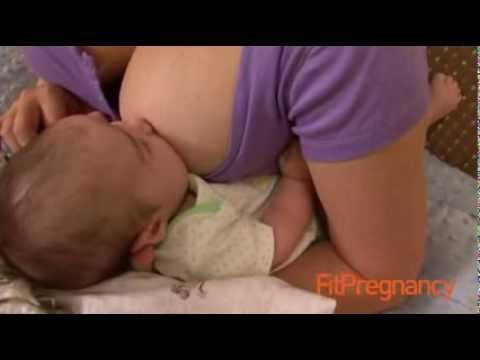
- Keep the massage short and sweet: While adults may like a 1 hour massage, infants need only 5-10 minute intervals of this type of touch.
- Always stop if baby shows signs she’s had enough: Such as crying, squirming, or falling asleep
- Avoid massage oils with harsh ingredients: Make sure whatever you use does not have artificial dyes, artificial perfumes, parabens, PEG, or EDTA.
- Be careful picking baby up after a massage: Massage oil can affect your grip and/or make baby slippery!
Check with baby’s pediatrician if baby has any underlying conditions that may interfere with a massage. For instance, some micropreemie babies cannot be handled too much due to changes in baby’s heart rate. Your healthcare provider can help decide what’s right for your baby.
A Note About Infant Massage
There’s no denying that some of these benefits are pretty amazing, but take your child’s lead.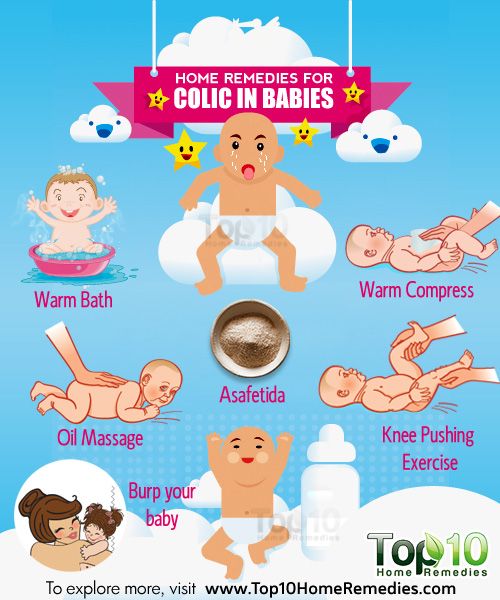 If he/she doesn’t like the massage, just stop for now; you can try again when baby is less fussy. The most important thing to do is keep it really simple—baby massage doesn’t have to be perfectly executed to be effective. Just be safe, have fun, and enjoy bonding with baby!
If he/she doesn’t like the massage, just stop for now; you can try again when baby is less fussy. The most important thing to do is keep it really simple—baby massage doesn’t have to be perfectly executed to be effective. Just be safe, have fun, and enjoy bonding with baby!
How About You?
Have you tried giving an infant massage to your baby? What benefits did it have for you or your baby?
Baby Massage - 6 Steps For A Nurturing Baby Massage
Kissing, tickling, blowing raspberries… how can you resist that deliciously soft baby skin or the precious giggles and chuckles as your little one responds to your loving touch?
Vitamin T — for touch, that is — is just as important a nutrient for your baby as the nutrition in the food he eats.
Touch is the first sense to develop, just days after conception and it is important to maintain health and well-being for a whole lifetime.
Although it is difficult to measure the effects of spontaneous touch between parents and babies such as all of the smooching, tickling and blowing of raspberries on tiny tummies, there are a number of studies into early skin to skin contact and baby massage showing amazing benefits for babies.
The best news is that you don’t need to buy expensive equipment or make radical changes to your daily workload.
Skin-to-skin contact between you and you baby at birth has been shown to reduce crying, to encourage mother-baby interaction and it keeps your baby warmer as his body temperature becomes stabilised by your own body.
It also makes breastfeeding easier as your baby is programmed to seek the breast naturally and this close contact will stimulate the release of oxytocin, the hormone that makes your breast milk flow.
If you miss skin to skin cuddles or are separated from your baby immediately after birth, studies of premature babies show that cuddling your little one skin to skin as soon as possible will still have profound effects on bonding, attachment, breastfeeding and your baby’s development.
Of course skin to skin contact is good for baby and you beyond those few precious hours after birth and taking a little time each day to introduce baby massage can be a wonderful time of sharing for either parent.
Massaging your baby stimulates all of your little one’s senses through skin contact, eye contact and your familiar smell as well as hearing your voice and experiencing a focussed response.
This loving interaction and sensory experience is hardwiring your baby’s immature brain for emotional and neurological development: as you touch and talk to your little one and share eye contact, you stimulate the development of connections between nerve cells in your baby’s brain that will form foundations for thinking, feeling and learning.
Massage Helps Your Baby Sleep Better Too
There is good news for tired parents too: a few simple strokes can lull your baby into a deeper, more restful sleep. According to Dr Tiffany Field, director of the Touch Research Institute at the Miami University School of Medicine, “a massage just before bedtime is more effective than rocking to help your baby fall asleep and stay asleep.”
Dr Field’s studies are affirmed by researchers from Warwick Medical School in the UK who looked at nine studies of massage covering a total of 598 infants aged less than six months.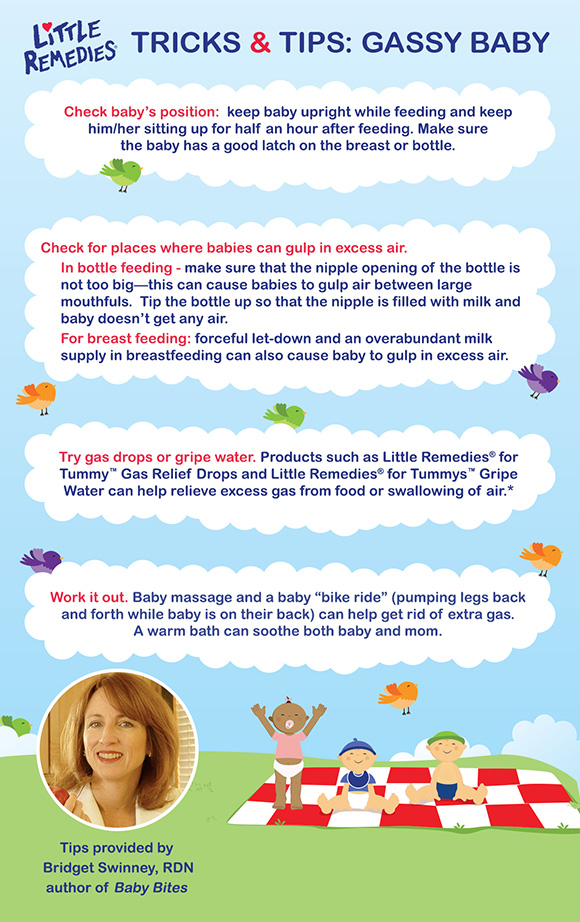 These studies showed that babies who were massaged cried less, slept better, and had lower levels of stress hormones compared to infants who did not receive massage.
These studies showed that babies who were massaged cried less, slept better, and had lower levels of stress hormones compared to infants who did not receive massage.
One of the studies also claimed that massage could affect the release of the hormone melatonin which is important in aiding infants’ sleeping patterns
Introducing Baby Massage
At first just gently stroking your baby’s legs and back is a lovely way to connect. It’s easy too if you have clothing that allows easy access such as nighties or two piece suits, rather than always buttoning your baby from top to toe in one piece suits.
As you introduce more formal massage it is important to choose a time of day that suits you and your baby so you can feel relaxed and your baby is receptive. Your aim is to help your baby develop an association that massage is relaxing and calming.
If you introduce a little at a time (you may start with just a leg massage, adding extra strokes gradually over a period of several days or weeks, depending on your baby’s age), with respect to your baby’s cues and tolerance, you will have a valuable tool in your parenting kit that can be used later to help him calm down when he is unsettled.
The best time to introduce massage will often be about twenty minutes or so after a feed when your baby is calm and alert. During the first three months your baby will probably find a massage AND a bath too stimulating so it’s best to massage and bath at separate times or massage one day and bath your baby the next day. If you move the two activities together, try massaging before your baby’s bath so he doesn’t get cold.
Always watch your baby closely to check how he is responding – which strokes does he enjoy? Which body parts are most comfortable for him to have massaged? Are there any spots that seem uncomfortable?
Some babies who have had painful procedures such as heel pricks for instance, may grimace as you touch their feet. If this happens, just hold that tiny foot in your hand and talk to your baby, “you are safe now, mama will hold your foot if it’s scary and soon you will be able to let me rub your foot again.”
If your baby becomes restless or unsettled, it is better to stop massaging than to push him along and create extra stress.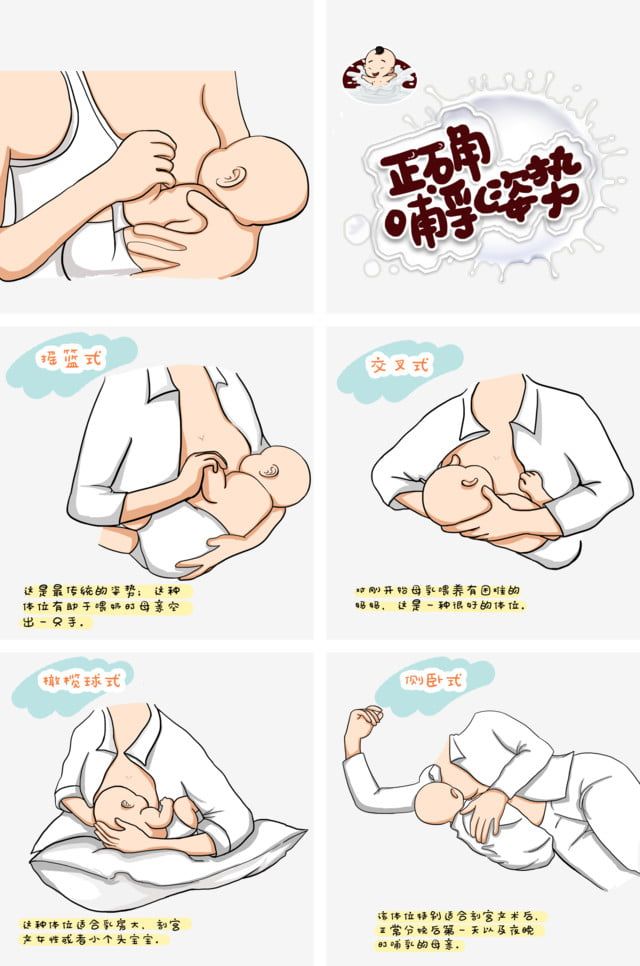
Remember too that massage can make your baby feel thirsty, so whenever he was last fed, if you massage, offer a top up afterwards. A massage, a bath and then a feed make a lovely bed time routine when your baby can manage this.
Do You Have Time To Massage Your Baby?
It can be daunting to think you have to fit another activity into your already busy day, just because it is good for your baby. Relax! You don’t have to set aside an hour to light candles and play gentle music to give your baby a ‘spa experience’.
Of course, if you want to do this it is a lovely way to help you both relax and bond but massage and ‘touchy feely’ games (’round and round the garden’ or ‘this little piggy’) can be easily incorporated into the busiest days, even if you have several littlies.
You can give your baby a leg and foot massage in just a few minutes as you change his nappy or a gentle back rub after a feed ” rub him skin to skin rather than ‘burping’ him through his clothing.
A tummy massage and a few leg bends will release lower bowel gas or help your baby poo so this can actually save you time if he is uncomfortable (alternate clockwise tummy circles with bending his legs up to his chest or ‘march’ them as you sing ‘the Grand old Duke of York’).
If you have more than one child, you can include your older tots in helping massage the baby or perhaps your toddler could massage a doll while you massage baby, then you could massage him.
Or massage could become a family ritual with each parent massaging a little one. The aim here is that one day your little ones will return the favour and give you a lovely back or foot rub!
Giving Your Baby A Mini Massage
Set up a quiet, warm space. Sit comfortably and relax by breathing deeply.
Undress your baby and keep him or her warm, then pour a small amount of natural vegetable oil (such as olive oil) in your palm and rub your hands together as you make eye contact and ask your baby, “would you like a massage?”.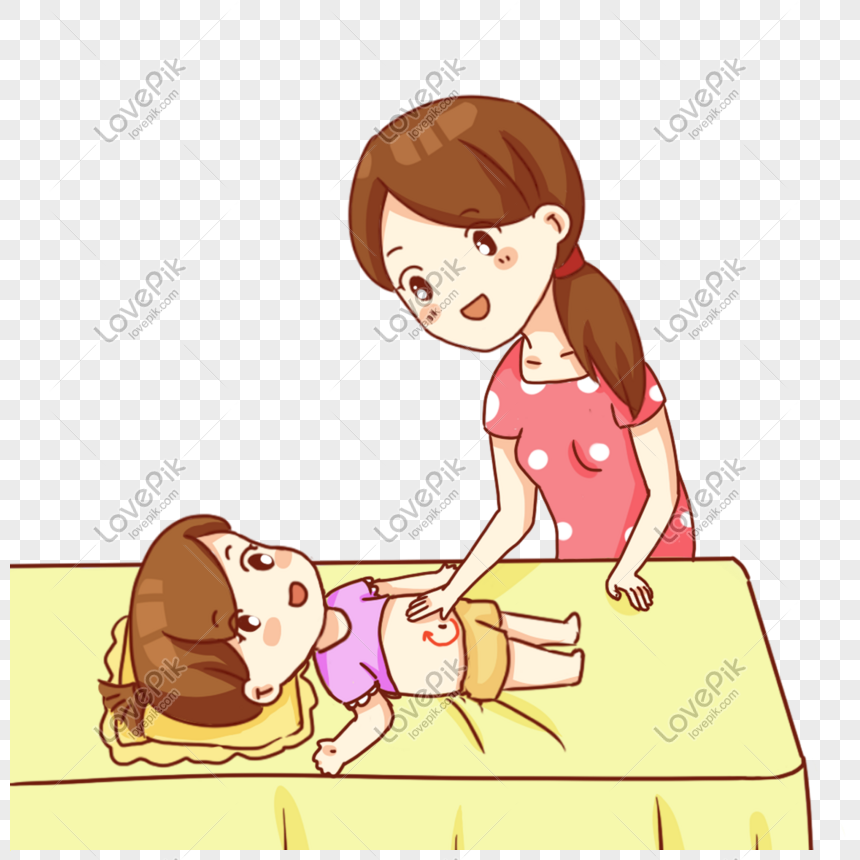 Time to get started!
Time to get started!
1: Massage Baby’s Legs and Feet
One leg at a time, cup your hands and alternating your hands (one supports baby’s ankle as the other strokes) ‘milk’ baby’s leg from hip to ankle. Firmly stroke baby’s sole from heel to toes then roll each toe. Finish by stroking both legs together from hips to ankles.
2: Massage Baby’s Stomach
With one hand following the other, massage baby’s stomach in continuous clockwise circles (following baby’s colon as this is the direction the food travels).
3: Massage Baby’s Chest
Place both hands on baby’s chest. With fingers flat, stroke up baby’s sternum, around the top of the chest, out to the shoulders, then back down to the bottom of your baby’s sternum, making a heart shape. Then, stroke gently outwards over baby’s shoulders.
4: Massage Baby’s Arms and Hands
‘Milk’ the arms one at a time, from shoulder to fingertips, then massage baby’s hands by pressing your own thumbs into his palm, before gently squeezing and rolling each finger.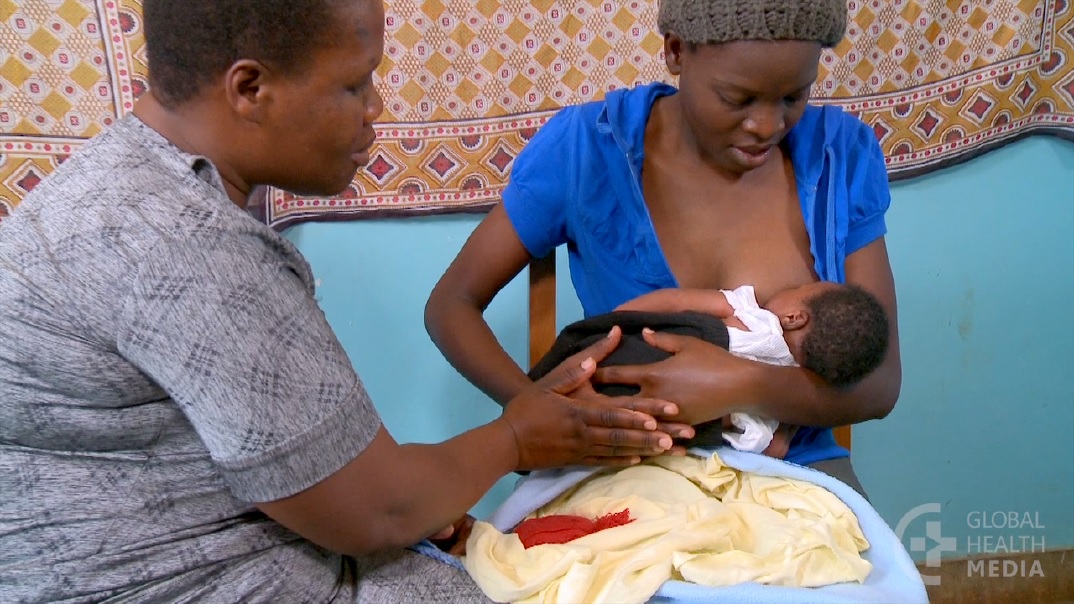 If baby’s hands are clenched shut, stroke or kiss the back of his hand to encourage him to open his hand.
If baby’s hands are clenched shut, stroke or kiss the back of his hand to encourage him to open his hand.
5: Massage Baby’s Face
With both hands supporting baby’s head, make gentle circles on baby’s scalp. Then, with flat fingers, stroke from the centre of the forehead out to the temples. With your fingertips, massage in small circles around baby’s jaw.
6: Massage Baby’s Back
Roll baby over onto his tummy or (if he resists tummy time) place him on his tummy (with his arms forward) across one of your thighs. With one hand on baby’s bottom, swoop your other hand from baby’s shoulders to buttocks.
Finish by lightly ‘combing’ baby’s back with your fingertips, from shoulders downwards, alternating hands. Gradually stroke lighter and slower, then finish by placing your hands on your baby’s back and breathe slowly with your baby.
Enjoy a cuddle with your calm, relaxed baby.
Baby massage. Tips for parents.
Massage of young children is carried out with a preventive, hygienic purpose, as well as in case of any deviations in the state of health or physical development, a violation of the normal function of the spine, a pronounced weakness of the muscles and ligamentous apparatus, a violation of the gastrointestinal tract and the transfer of various diseases.
Massage has a comprehensive development on the child's body. The reaction of the body to massage is different and depends on the techniques used, the duration of exposure. For example, stroking, rubbing - relax the muscles, and tapping, patting - cause the appearance of muscle tone. Under the influence of massage, blood and lymph flow, metabolic processes, and the release of metabolic products are accelerated. nine0003
When exposed to massage techniques on the skin, muscles, ligaments, there are responses from various organs and systems.
There is a close functional relationship between the muscular system and the function of internal organs, smooth muscle tone. Therefore, massage causes a positive reaction from the digestive tract, this is especially important for constipation, colic in infants, after the massage, gases are well removed.
Massage stimulates the growth and development of muscle mass, helps to maintain optimal tone, is a kind of irritant to the receptors of the skin and deeper tissues.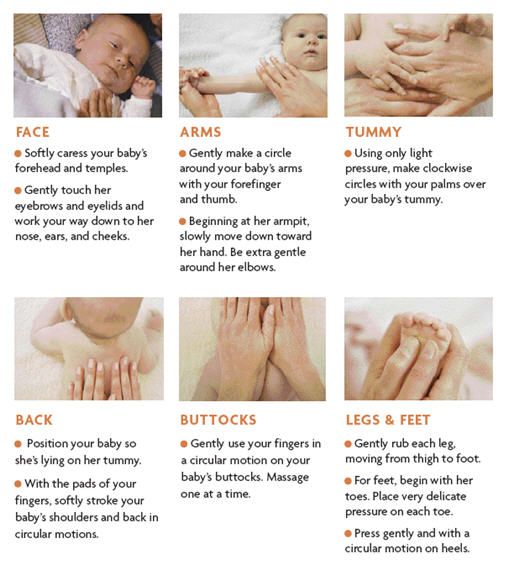 Despite the small mass of the child, the surface of the skin is relatively larger than that of adults. This partly explains the great sensitivity of the child to the action of massage. The baby's skin is soft and smooth. The capillary network of the skin is highly developed and hyperemia quickly occurs after the massage. Given the increased excitability of the nervous system, the presence of a large number of receptors in the skin, it is possible to explain the increased sensitivity of the child to the effects of massage. nine0003
Despite the small mass of the child, the surface of the skin is relatively larger than that of adults. This partly explains the great sensitivity of the child to the action of massage. The baby's skin is soft and smooth. The capillary network of the skin is highly developed and hyperemia quickly occurs after the massage. Given the increased excitability of the nervous system, the presence of a large number of receptors in the skin, it is possible to explain the increased sensitivity of the child to the effects of massage. nine0003
Diseases are not uncommon in early childhood, and massage is one of the important methods of complex treatment. It is simple to perform and it can be mastered and carried out by the mother of the child herself, having previously been trained by a masseuse.
Massage for certain diseases:
- Rickets (only not in the peak period!!!) - massage improves metabolic processes, prevents the progression of the disease, deformation of the musculoskeletal system, increases blood circulation in the massaged area, stimulates redox processes in the muscles .
 Massage normalizes sleep. The massage is carried out carefully. I use stroking and rubbing. The duration of the procedure is 5-7 minutes. nine0018
Massage normalizes sleep. The massage is carried out carefully. I use stroking and rubbing. The duration of the procedure is 5-7 minutes. nine0018 - Change in muscle tone - with muscle hypertonicity, hypotonicity or muscle dystonia. The massage techniques in this case are varied, stroking, rubbing, tapping and patting are used.
- Umbilical hernia - the purpose of the massage is to increase the tone of the muscles of the umbilical ring, prevent the divergence of the straight abdomen, and as a result, reduce the risk of hernia incarceration.
- Colic in infants - the purpose of the massage is to stimulate intestinal motility, gas discharge. The abdomen is massaged with stroking movements clockwise, after which the baby is laid on the stomach and the back is massaged with stroking movements. nine0018
- Flat feet, congenital hip dislocation, muscular torticollis, congenital clubfoot. Massage for these diseases should be carried out in a clinic or at home by an experienced masseuse.

Contraindications for massage in young children:
- Acute infectious diseases.
- Rickets at its peak with hyperesthesia.
- Various forms of hemorrhagic diathesis.
- Inguinal, umbilical, femoral hernias with a tendency to incarceration. nine0018
- Congenital heart defects with severe cyanosis and compensation disorder.
- Pustular, acute inflammatory diseases of the skin.
When performing a massage, a number of rules must be observed: the temperature in the room should not be lower than 22-24 degrees.
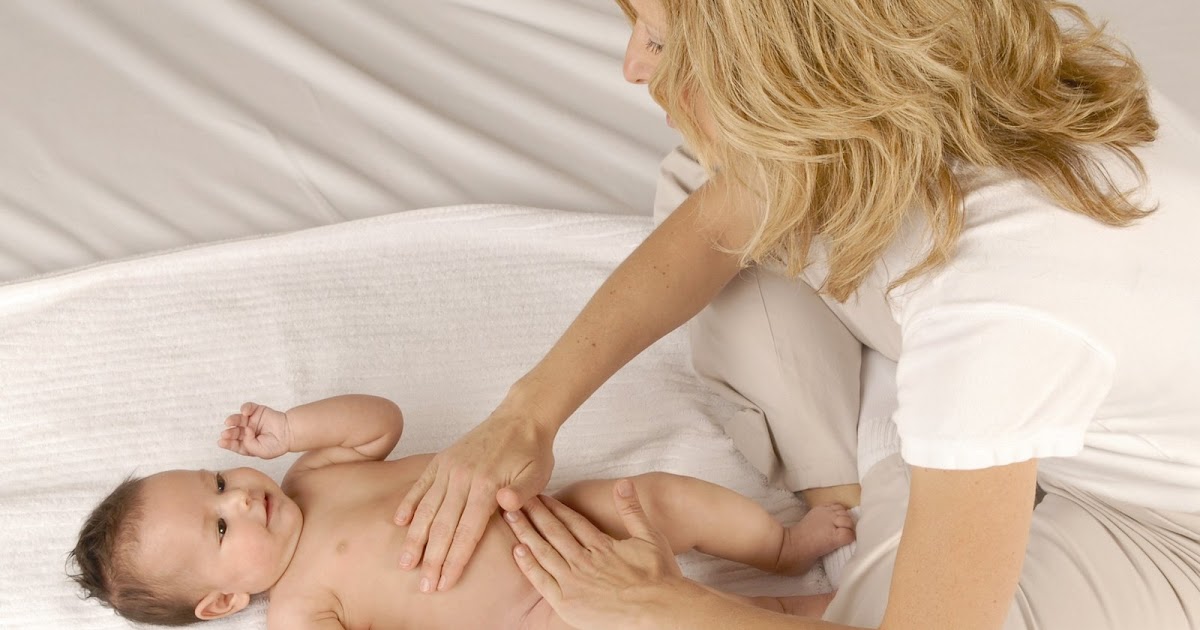
A set of exercises for children from 10-15 days of life to 3 months of age:
- Stroking hands (4-6 times) nine0017 Foot stroking (4-6 times)
- Laying out on the stomach
- Back massage (4-6 times)
- Abdominal massage (6-8 times)
- Reflex crawl
- Foot massage and reflex exercises.
 (3-4 times).
(3-4 times).
As the child grows, new elements are added to the daily set of exercises, and the duration of the procedure increases. A pediatrician and a nurse - a masseuse will tell you more about the technique of massage and gymnastics. nine0003
Incorrect, uncertain execution of techniques can cause discomfort in a child and cause harm instead of benefit. Therefore, before you begin to massage and exercise your baby on your own, consult a specialist.
Author of the material: pediatrician of the clinic on Rodionovskaya Kolinichenko T.V.0003 > Massage for newborns Where to buy Author, editor and medical expert - Anna Alexandrovna Petrashevich. Editor and medical expert - Harutyunyan Mariam Harutyunovna. Views: 45 041 The date of the last update: 06/23/2022 G. Average reading time: 5 minutes Content: How best to massage a baby Preventive massage is becoming increasingly popular 5 among healthy babies 3 . Massage helps develop baby's muscles, prevent colds, gain weight 5 , and most importantly, strengthen the emotional bond between mother and child 2 . Experts recommend starting massage from the first month of life 3 . It well complements gymnastics and daily routines for child care up to the year 2.3 . Therapeutic or rehabilitation massage is prescribed by a doctor if indicated. These may include developmental disabilities or serious illnesses. The more complex the pathology, the more carefully the technique is selected. Specialists in physiotherapy exercises, masseurs and rehabilitation specialists work with such kids 2.5 . Preventive massage is quite possible for parents. It can be carried out on your own, but only after training with a pediatrician who provides accessible and visual instruction for moms and dads 2 . Before the session, make sure that you have taken into account all the conditions 3 : Infant massage somewhat limited 3 . It is possible to massage the whole body 1 , but only strokes are allowed for newborns 3 . They should be performed gently, at a slow pace, while passive movements should be large enough to complement the child's natural motor activity 1 . Gently stroke along the massage lines without pressure. You can talk to your child during the session. When massaging before going to bed, remember that your voice should be calm and not too emotional 3 . European paediatricians recommend massaging children under one year of age using oils 4 . The choice of oil should be approached responsibly. There are special baby oils for newborns, such as JOHNSON'S ® Baby Oil "Cotton Delicate", which meets the needs of delicate baby skin. Hypoallergenic product 7 . It is free of dyes, phthalates and parabens 6 . Up to content
A set of exercises  This is not just a pleasant procedure. In addition to a lot of pleasure, the baby receives great benefits from the gentle touches of the mother.
This is not just a pleasant procedure. In addition to a lot of pleasure, the baby receives great benefits from the gentle touches of the mother.
How best to massage your baby
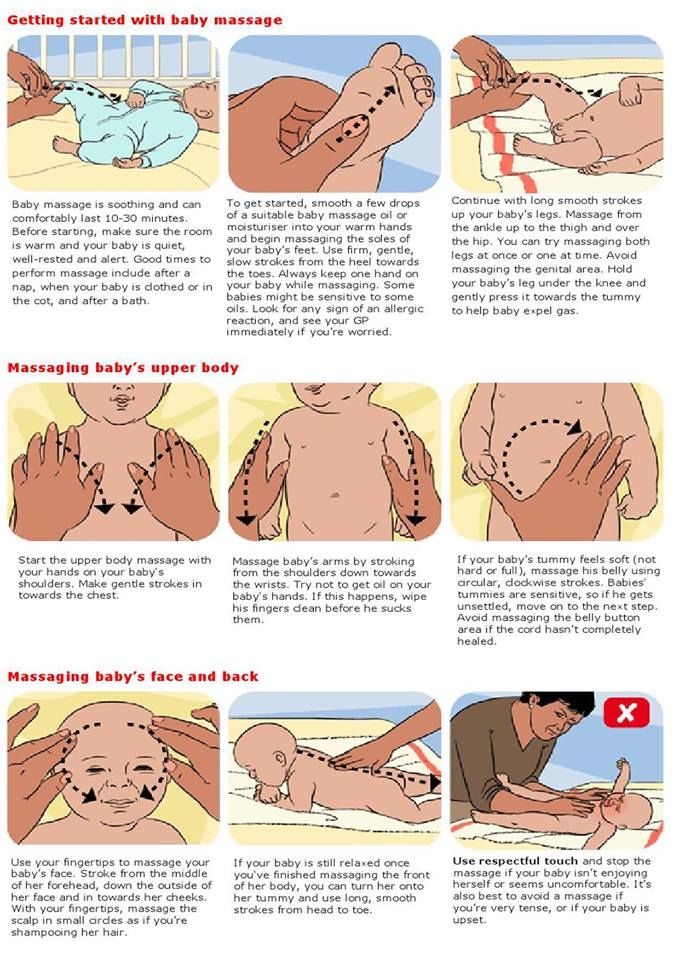
 Therefore, rub them - so they will warm up.
Therefore, rub them - so they will warm up. 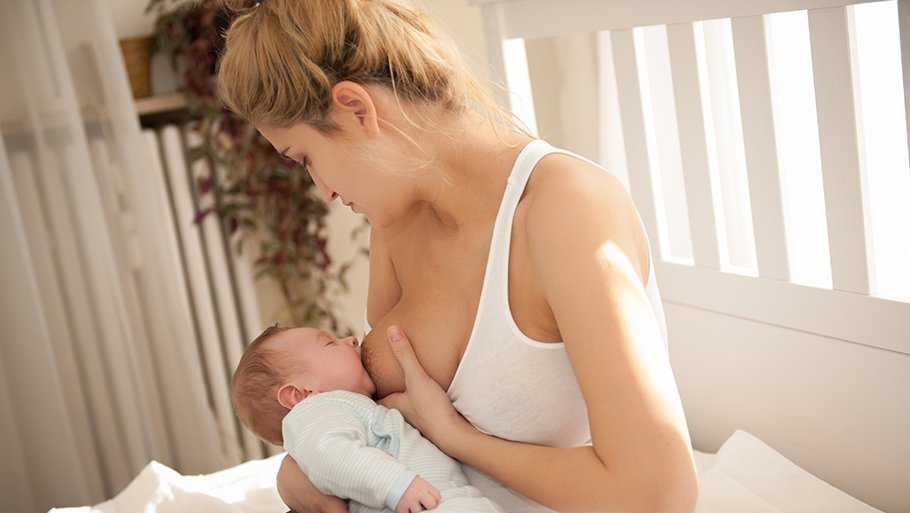 JOHNSON'S ® Cotton Tenderness Baby Oil is a plant-based formula containing coconut and cottonseed oils that absorbs quickly and protects baby's skin from dryness 3.6 while its "scent of happiness" 9 promotes baby's multi-sensory development 10-13 .
JOHNSON'S ® Cotton Tenderness Baby Oil is a plant-based formula containing coconut and cottonseed oils that absorbs quickly and protects baby's skin from dryness 3.6 while its "scent of happiness" 9 promotes baby's multi-sensory development 10-13 . Complex of exercises0140 3
:
- Pour a small amount of baby oil into your palm. Remember that it can only be applied to dry baby skin.
- Start massaging your face and neck with your fingertips. With soft and gentle movements, draw over the baby's ears, then along the line of the eyebrows, nose and lips, as if "drawing" them.
- Move to the baby's tummy. Stroke it with your palm in a clockwise direction, avoiding the area of \u200b\u200bthe right hypochondrium, where the liver is located.
- After the abdomen, massage the chest with your thumbs, but in such a way that there is no pressure on the chest. Move from the center to the sides.
 nine0018
nine0018 - Start massaging the arms with the hand, gradually moving up to the shoulder. Don't forget your palms. Open them and with the pads of your thumbs make circular movements several times. Then you need to stroke each finger and massage the tubercle of the thumb.
- The legs also need to be massaged from the bottom up - from the foot to the thigh. Foot massage should be given special attention - gently stroke the top of the foot, ankle and sole.
- Do a little "warm-up" for your fingers. Massage each one separately, and then apply light pressure on the sole under the fingers. In response to this, the baby will squeeze his fingers. To open them, run along the outer surface of the foot - from the little finger to the heel. nine0018
- End with a back massage. To do this, turn the child on his stomach and stroke the back from top to bottom - from the neck to the buttocks - and then back.
After the session, dress your baby in warm underwear and let him lie down quietly. If you have used oil, be sure to remove any remaining oil from your skin before putting on diaper 3 .
If you have used oil, be sure to remove any remaining oil from your skin before putting on diaper 3 .
Newborn massage is a necessary element of adequate physical activity, which has many positive effects, especially when carried out using quality baby oil 4 . The effect on skin receptors has a tonic effect on the nervous system of the child 5 and promotes the physical and mental development of the child's body 2 . This is especially important in early childhood, when all the child's future skills are laid and basic movements are formed, for example, crawling, standing, sitting and walking 1 .
The information in this article is for reference only and does not replace professional medical advice. For diagnosis and treatment, contact a qualified specialist. nine0092
Up to contents
Literature:
- AP Romanchuk, VV Beseda. Massage gymnastics as one of the forms of physical education of young children // Pedagogy of physical culture and sports.
 - 2009. C. 94-96. https://cyberleninka.ru/article/n/massazhnaya-gimnastika-kak-odna-iz-form-fizicheskogo-vospitaniya-detey-rannego-vozrasta
- 2009. C. 94-96. https://cyberleninka.ru/article/n/massazhnaya-gimnastika-kak-odna-iz-form-fizicheskogo-vospitaniya-detey-rannego-vozrasta - A. I. Zaev, I. I. Makarova, Yu. A. Aleseeva, Z. B. Zaeva. Modern assessment and prospects for the use of physical exercises and massage in children of the first year of life // Human Ecology. - 2007. - No. 04. - C. 28-31. https://cyberleninka.ru/article/n/sovremennaya-otsenka-i-perspektivy-primeneniya-fizicheskih-uprazhneniy-i-massazha-u-detey-pervogo-goda-zhizni
- JOHNSON'S ® Care from day one. Information and educational guide for child care from the first days of life. Developed jointly with leading Russian experts.
- Blume-Peitawi U., Lavender T, Dzhenerovich D and others. Recommendations of the European Round Table on Healthy Infant Skin Care // Journal for Continuing Medical Education of Physicians. Neonatology: news, opinions, training. - 2017. - No. 1. C. 108-118.
- E.Isaeva. Children's massage. Step by step guide.
